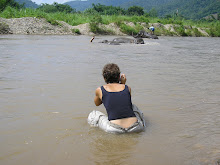
Our Stress Escape Tours to Thailand (Thai Massage course, yoga retreats and unique journeys) see:
http://www.stressescapetours.com/ always begin with a trip to Wat Po.
The temple of the reclining Buddha is in the Wat Po compound of Bangkok. Within the narrow Wat is a Reclingin Buddha (46 meters long and 15 meters high). O nthe soles of the feet are 108 auspicious scenes in Chinese and Indian styles. Along the far wall are 108 alms bowls. We take a cup of nmoinal coins and walk down the hall dropping a coin in each bowl. Clink, clink, clink, prayers said, wishes made, blessings sent.

In researching the significance of 108 auspicious blessings, (the number of bowls in the temple of the reclining Buddha in Bangkok), I found the following information on:
http://www.hknet.org.nz/108meaning.htmlSHOSHU BUDDHIST Followers use 108 beads in their malas. They

implement the following formula: 6 x 3 x 2 x3 = 108 6 senses [sight, sound, smell, taste, touch, thought] 3 aspects of time [past, present, future] 2 condition of heart [pure or impure] 3 possibilties of sentiment [like, dislike, indifference]
BUDDHA’S FOOTPRINT All Buddhists accept the Buddha Footprint with its 108 Auspicious Illustrations. These areas are considered to have been marked on the Buddha’s left foot when his body was discovered.
BUDDHISM 108 beads on the Hindu maalaa {rosary} 108 Arhats or Holy Ones
HINDUISM 108 Gopis {consorts} of Lord Krishna 108 Holy places for Vaishnavas 108 beads on the Japa maalaa {rosary} 108 Upanishads 108 Divyadeshes - Divine or Sacred Tirtha throughout India and Nepal 108 sacred water taps in Muktinath - Nepal
TANTRA SHASTRA 108 Pitha {Sacred Places} The story goes that Lord Shiva was in deep and incessant meditation. His asceticism was creating great heat in the universe. All existence was in peril and Lord Brahma was deeply concerned. Lord Brahma asked the Mother of the Universe, Maa Shakti, to use Her strength and wile to seduce Lord Shiva. Maa Shakti agreed and was born as Sati, daughter of Shri Daksha. Lord Shiva was so entranced by Sati’s asceticism and extraordinary beauty that he took human form and they were married. Years later, at a feast, Sati’s father insulted Lord Shiva. Sati was so humiliated that she began a deep meditation which led to her immolation. Lord Shiva was completely heart broken. He reached into the sacrificial fire and pulled out as much of His beloved’s body as he could grab. As He ascended to heaven, bits of Sati’s body fell to earth. 108 bits to be precise! In time, these places were acknowledged and worshipped.
SANATANA DHARMA In a book by Khurana, the explanation closely mirrors the original Vedic justifications: A circle has 360 degrees, which when multiplied by 60 gives us 21,600 minutes in a circle. 60 comes from the 60 'ghatis' which Sanatana Dharmiks believe in. One ghati is equal to 24 minutes and 60 ghatis come to 24 hours.
One ghati is divided into 60 parts or 'palas'. So the 60 ghatis multiplied by 60 palasa comes to 3,600. This is further multiplied by 60 (becase a pala contains 60 vipalas) which gives us 21,600. Half of this is for the day, and the other half for the night. So, 21,600 divided by 2 gives us 10,800. For practical purposes, we use 108. Using the number 108 helps us coordinate the rhythm of time and space & we remain in harmony with the spiritual powers of nature.




 Our Stress Escape Tours to Thailand (Thai Massage course, yoga retreats and unique journeys) see: http://www.stressescapetours.com/ always begin with a trip to Wat Po.
Our Stress Escape Tours to Thailand (Thai Massage course, yoga retreats and unique journeys) see: http://www.stressescapetours.com/ always begin with a trip to Wat Po.



 Home to over 1,000 Buddha images, Wat Po is one of the oldest wat’s (temples) in Bangkok. It is also the home of the famous reclining Buddha (Phra Buddhasaiyas). At forty six meters long and fifteen meters high, the Reclining Buddha is one of the largest single Buddha images, covered in gold with the soles of his feet displaying 108 auspicious scenes, which distinguish a true Buddha, in both Indian and Chinese styles with inlay of mother of pearl.
Home to over 1,000 Buddha images, Wat Po is one of the oldest wat’s (temples) in Bangkok. It is also the home of the famous reclining Buddha (Phra Buddhasaiyas). At forty six meters long and fifteen meters high, the Reclining Buddha is one of the largest single Buddha images, covered in gold with the soles of his feet displaying 108 auspicious scenes, which distinguish a true Buddha, in both Indian and Chinese styles with inlay of mother of pearl.